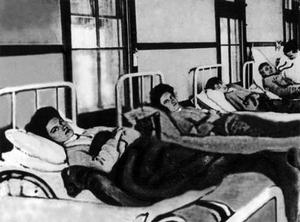Public healthWhy typhoid fever pathogen targets only humans
Salmonella typhiis a particularly nasty bacterium that targets only humans and causes typhoid fever, which kills hundreds of thousands of people annually; scientists explain how evolution shaped the pathogen to be so selective

"Typhoid Mary" Mallon in forced quarantine in 1907 // Source: commons.wikimedia.org
Salmonella typhiis a particularly nasty bacterium that targets only humans and causes typhoid fever, which kills hundreds of thousands of people annually. In a new study appearing in the 16 November issue of the journal Science, Yale scientists explain how evolution shaped the pathogen to be so selective.
A Yale University release reports that Jorge E. Galan, the Lucille P. Markey Professor of Microbial Pathogenesis, and colleague Stefania Spano coaxed Salmonella typhi to survive within immune cells of mice — a species that in nature cannot be infected with the pathogen. They managed the trick by introducing a single gene from a related strain of Salmonella that can infect multiple species. The gene enable S. typhi to destroy a molecular courier known as Rab32, which under normal conditions helps arm anti-microbial defenses against the invader.
In humans, however, the antimicrobial defenses delivered by Rab32 are not effective against S. typhi, and this pathogen can establish itself and cause disease.
“The immune system is still firing the bullets, but this pathogen has learned how to dodge them in humans but apparently not in other animals,” Galan said.
Unlike the Salmonella bacteria that cause food poisoning, S. typhi can be fatal in up to 20 percent of untreated cases. People contract typhoid fever through contaminated food or water, and survivors can sometimes carry the pathogen for years. The loss of a single gene in S. typhi gives clues as to why it has lost the ability to replicate in any host other than humans, Galan said.
Deficiencies in the Rab32 surveillance mechanism may also make people more susceptible to leprosy and tuberculosis.
Understanding how the surveillance system works may lead to new strategies to combat a those infectious diseases and help develop new classes of antibiotics to combat pathogens, which are developing resistance to current drugs.
— Read more in Stefania Spanò and Jorge E. Galán, “A Rab32-Dependent Pathway Contributes to Salmonella Typhi Host Restriction,” Science 338, no. 6109 (16 November 2012): 960-63 (DOI: 10.1126/science.1229224)
